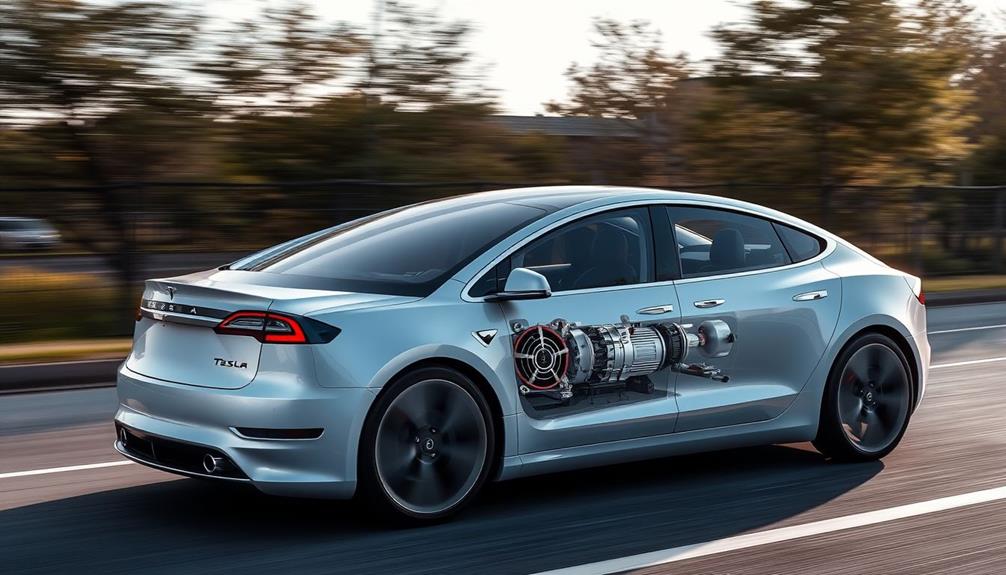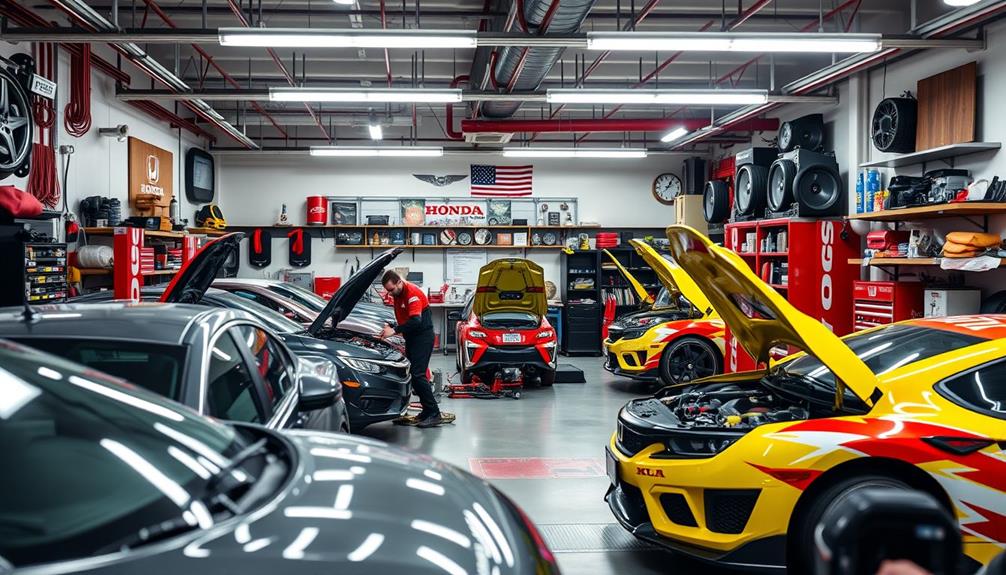Teslas don't use traditional multi-speed transmissions; they rely on a single-speed transmission instead. This system provides instant torque, allowing for smooth, seamless acceleration without the need for gear shifting. You'll enjoy consistent power delivery, which makes your driving experience thrilling and efficient. With fewer moving parts, maintenance is simpler and costs are lower. This design not only enhances performance but also reduces mechanical wear over time. Curious about how these features translate to driving efficiency and overall experience? There's more to discover about the unique technology behind Tesla's performance.
Key Takeaways
- Tesla vehicles use a single-speed transmission, allowing for direct power transfer without gear shifting.
- This transmission provides 100% torque at low speeds, ensuring instant acceleration and a smoother driving experience.
- The simplified design reduces mechanical wear and lowers maintenance needs compared to multi-speed transmissions.
- Tesla's single-speed system enhances energy efficiency and performance, resulting in consistent power delivery across different driving conditions.
- Continuous software updates improve power delivery and overall performance without the need for traditional servicing.
Tesla's Unique Transmission System

When you drive a Tesla, you'll notice its unique transmission system sets it apart from traditional vehicles. Tesla employs a single-speed transmission, which allows for direct power transfer from the electric motors to the wheels. This design eliminates the need for gear shifting, resulting in a smoother driving experience. You won't have to deal with the clunky feel of changing gears, making your rides more enjoyable.
Thanks to electric motors delivering 100% torque at low speeds, multiple gears aren't necessary. This efficiency means you can reach various speeds seamlessly, enhancing your overall performance. The absence of complex gear systems also minimizes drivetrain loss, which is a common issue in multi-speed transmissions. This not only improves energy efficiency but also maximizes the vehicle's performance across different driving conditions.
With Tesla's simplified transmission setup, you can expect consistent performance, whether you're accelerating on the highway or maneuvering city streets. This innovative approach to transmission helps maintain the reliability that Tesla is known for, ensuring you get the most out of your electric driving experience.
Advantages of Tesla's Transmission
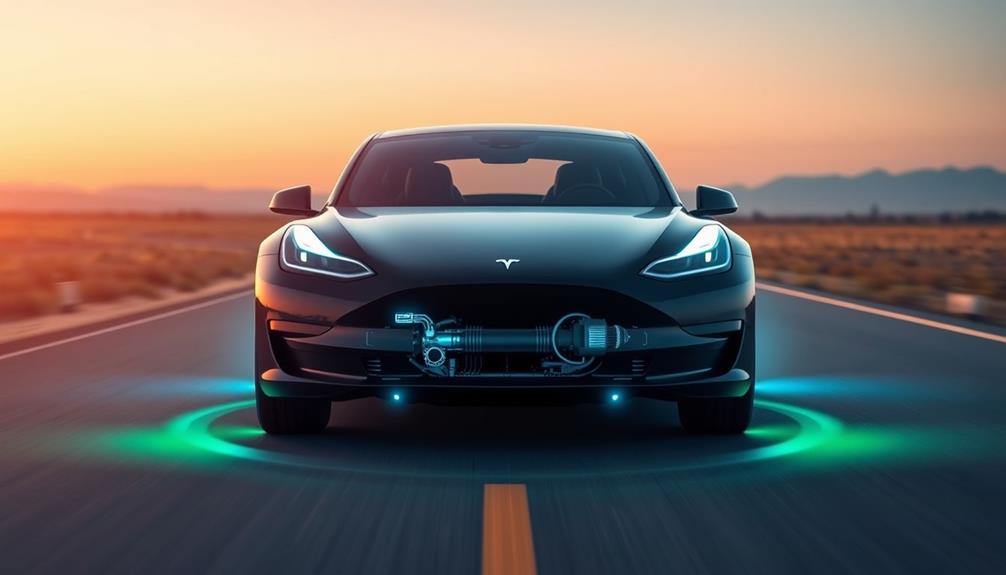
When you drive a Tesla, you experience the benefits of a simplified transmission design that enhances driving efficiency.
With a single-speed system, there's no gear shifting, which means smoother acceleration and less mechanical wear over time.
This streamlined approach not only boosts performance but also makes your driving experience more enjoyable.
Simplified Design Benefits
Tesla's single-speed transmission system offers considerable advantages over traditional multi-speed setups. By simplifying power delivery from the electric motor to the wheels, Tesla eliminates the need for gear shifting, creating a more efficient driving experience. This design considerably reduces drivetrain loss, enhancing overall efficiency while minimizing friction and drag.
- Fewer moving parts lead to lower maintenance needs and a reduced likelihood of mechanical failures.
- The absence of multiple gears guarantees consistent power delivery, allowing for exceptional acceleration and smooth driving experiences.
- The streamlined design contributes to the vehicle's reliability and longevity, reinforcing Tesla's reputation for performance.
With a single-speed transmission, you experience the thrill of immediate torque without the interruptions of shifting gears. This means you can enjoy a seamless ride, whether you're accelerating from a stoplight or cruising on the highway.
Enhanced Driving Efficiency
Experience the remarkable driving efficiency of Tesla's single-speed transmission, which revolutionizes how power is transferred from the electric motor to the wheels. This innovative design enhances overall efficiency and reliability, making Tesla cars stand out in the electric vehicle market.
By utilizing a single-speed transmission, Tesla eliminates the complexity of multiple gears, leading to fewer moving parts and considerably reduced maintenance needs compared to traditional vehicles.
One of the most notable advantages is that Tesla's electric motors deliver 100% torque at low speeds. This means you won't experience any lag or need to shift gears, allowing for smooth and instantaneous acceleration. You can enjoy a responsive driving experience, whether you're traversing city streets or cruising on the highway.
Moreover, the straightforward single-speed setup minimizes drivetrain loss, maximizing energy efficiency during your drives. This design not only enhances performance but also contributes to a more enjoyable ride.
As you drive a Tesla, you'll appreciate the seamless power delivery and efficient operation, making your journeys both thrilling and sustainable. With Tesla, you're not just driving a car; you're experiencing the future of efficient automotive engineering.
Comparison With Other Electric Vehicles

While many electric vehicles adopt complex multi-speed transmissions to enhance performance, Tesla stands out with its single-speed design. This choice simplifies the drivetrain mechanics, making it easier to maintain while increasing reliability.
In contrast, competitors like the Porsche Taycan leverage multi-speed transmissions to optimize torque and efficiency across different speed ranges.
Consider these key differences:
- Performance: Tesla's single-speed transmission delivers smooth acceleration without the need for gear changes.
- Efficiency: The straightforward design of Tesla's system can lead to better energy use in certain driving conditions.
- Maintenance: Fewer moving parts in Tesla's drivetrain often result in lower maintenance needs compared to multi-speed setups.
While Tesla excels in consistent power delivery, other electric vehicles with multi-speed transmissions can fine-tune performance for specific scenarios.
As the electric vehicle market evolves, we may see more manufacturers exploring multi-speed designs. However, Tesla's efficient single-speed transmission has proven effective, showcasing a different engineering philosophy that prioritizes simplicity and reliability over complexity.
Tesla Model Overview

Electric vehicles have been revolutionizing the automotive landscape, and Tesla’s lineup showcases some of the most advanced options available today. With models like the Model S, Model 3, Model X, and Model Y, Tesla vehicles are designed for performance and efficiency. Tesla’s electric motors deliver impressive acceleration and a smooth, quiet ride. The consistently high ratings for range and charging speed demonstrate Tesla’s commitment to pushing the boundaries of electric vehicle technology. Whether it’s the Tesla Model S with its sleek design and impressive tesla engine power, or the Model 3 with its more affordable price point and agile handling, Tesla’s lineup offers something for everyone looking to make the switch to electric.
The Model S stands out with its luxurious design and impressive range, while the Model 3 offers a sporty experience, achieving 0 to 60 mph in just 3.2 seconds thanks to its dual electric motors. You'll appreciate the Model 3's range of 310 miles on a single charge, making it perfect for long drives.
The Model Y, with a weight of approximately 4,416 lbs, provides ample space for families, while the larger Model X, weighing around 5,421 lbs, combines utility with style.
All Tesla models utilize a single-speed transmission that not only enhances efficiency but also simplifies your driving experience by eliminating the need for gear shifting.
Additionally, Tesla vehicles come equipped with sophisticated features, including an extensive camera system for 360-degree visibility.
With continuous software updates, your Tesla keeps improving, ensuring you always have the latest technology at your fingertips.
Driving Experience and Efficiency
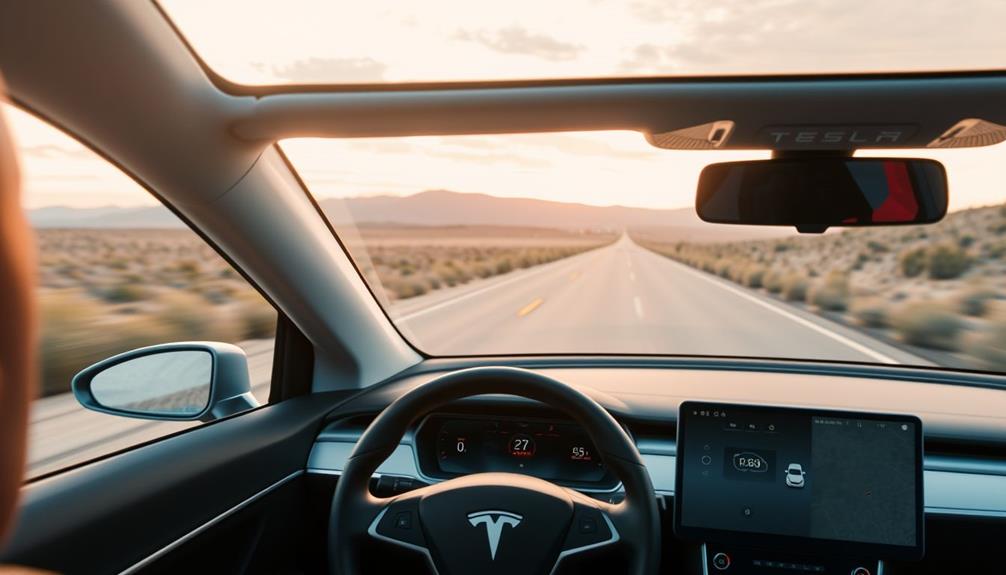
When you drive a Tesla, you'll immediately notice the benefits of instant torque, which gives you quick acceleration at any speed.
Plus, with regenerative braking, you not only enhance your driving efficiency but also extend the life of your brakes.
This combination makes for a smoother, more enjoyable ride while keeping maintenance needs low.
Regenerative Braking Benefits
Often overlooked, regenerative braking in Tesla vehicles greatly enhances your driving experience and efficiency. This innovative system captures energy during braking and converts it back into electricity, extending your vehicle's range while markedly improving driving efficiency.
You'll notice how well it performs, especially in stop-and-go traffic, where it maximizes energy recovery.
Here are some key benefits of regenerative braking in your Tesla:
- Reduced Brake Wear: Brake pads can last over 100,000 miles, meaning you won't have to replace them as often as with traditional vehicles.
- Lower Maintenance Costs: By relying less on conventional braking systems, your overall maintenance costs decrease, allowing you to save money in the long run.
- Enhanced Driving Experience: The instant torque provided by regenerative braking makes acceleration more engaging and responsive.
Embracing regenerative braking not only contributes to a more enjoyable ride but also promotes sustainability.
Instant Torque Availability
The thrill of driving a Tesla comes from its instant torque availability, which transforms every acceleration into an exhilarating experience. With Tesla's electric motor, you get 100% of the torque at zero RPM, meaning you can launch from a standstill with incredible responsiveness.
Unlike traditional vehicles with multiple gears, Tesla's single-speed transmission guarantees smooth and linear power delivery across the entire speed range. This seamless acceleration makes driving a Tesla feel unique and superior to conventional cars.
Imagine going from 0 to 60 mph in as little as 3.2 seconds, as seen in the Model 3. That's the kind of performance you can expect, thanks to the instant torque that electric motors provide. You won't just notice the speed; you'll feel the thrill in every fiber of your being.
Moreover, the regenerative braking system adds to the driving experience by recovering energy during deceleration, enhancing overall efficiency.
This combination of instant torque and smooth acceleration not only elevates performance but also creates a driving experience that's both enjoyable and efficient. You'll find that every drive in a Tesla isn't just about getting from point A to B; it's about enjoying the journey.
Safety Considerations for Electric Vehicles
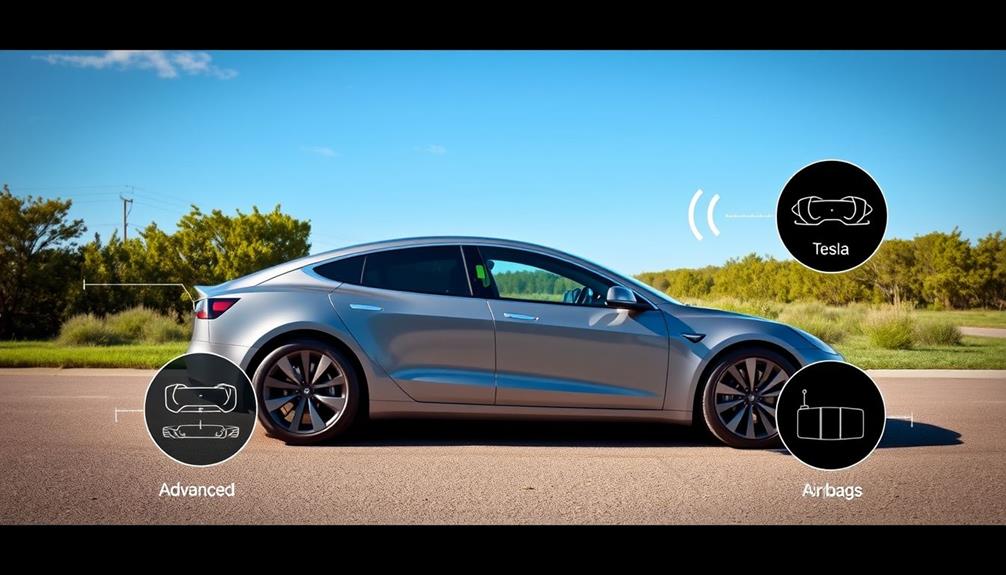
Safety considerations for electric vehicles (EVs) are essential, particularly given their unique risks.
With high voltage systems that can reach up to 650 volts DC, mishandling can result in fatal consequences. It's important to understand the safety measures in place to protect you and others on the road.
- First responders need specialized training to deal with EVs, recognizing the dangers of stored energy and silent operation.
- The lack of engine noise can pose challenges, increasing the risk of accidents for pedestrians and other road users.
- Regular maintenance, especially regarding battery preconditioning and charging, is critical for ensuring safety and reliability.
Future of Electric Vehicle Transmissions
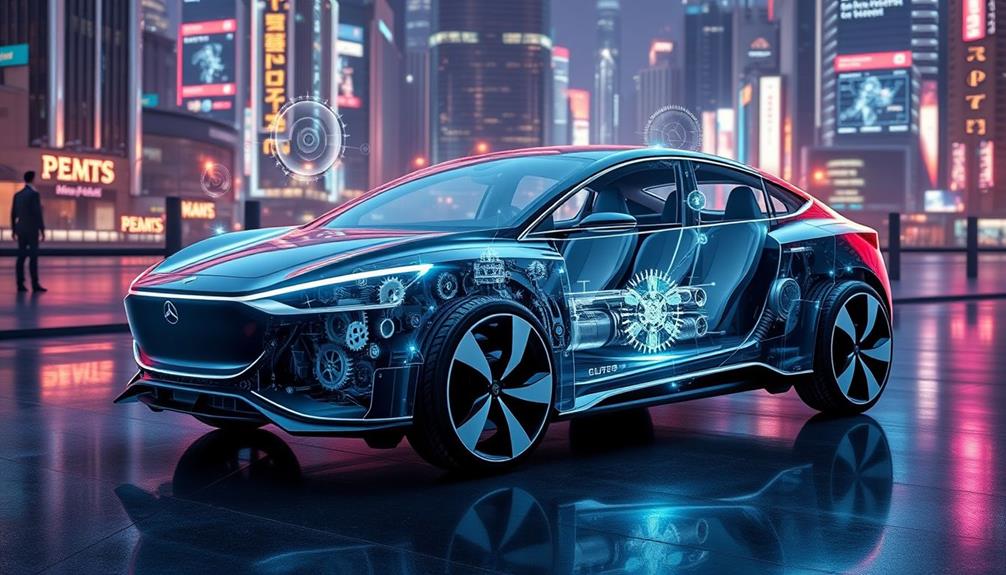
Exploring the future of electric vehicle transmissions reveals a landscape ripe for innovation and performance enhancement. As electric vehicles gain popularity, manufacturers are increasingly focused on developing multi-speed systems that can boost power, efficiency, and overall performance.
Companies like Continental AG and ZF Friedrichshafen AG are investing heavily in technologies that promise to revolutionize how transmissions work in electric vehicles.
While Tesla has primarily opted for a single-speed transmission, the Porsche Taycan showcases the advantages of multi-speed gearboxes. These systems can improve acceleration and torque management across different speed ranges, offering drivers a more dynamic experience.
Research and development efforts aim to strike a balance between the simplicity of single-speed setups and the potential efficiency gains of multi-speed systems.
Historical advancements in internal combustion engine transmissions hint at exciting possibilities for electric vehicles, suggesting that future models may feature performance-oriented designs.
As consumer preferences evolve, the demand for innovative transmission options will likely shape the next generation of electric vehicles, ultimately enhancing your driving experience with improved power and efficiency.
Maintenance of Tesla Transmissions

When it comes to maintaining Tesla transmissions, you'll find that the single-speed system simplifies the process considerably. Unlike traditional vehicles with complex multi-speed transmissions, Teslas come with fewer moving parts, which means less hassle for you.
This design minimizes drivetrain loss, enhancing efficiency and reducing the likelihood of mechanical failures.
Your maintenance routine for a Tesla is minimal. Here are a few key points to keep in mind:
- No fluid changes: Electric motors don't require the regular fluid changes that traditional gearboxes do.
- Fewer repairs: The direct power transfer from the electric motor to the wheels boosts reliability and performance, leading to fewer issues.
- Software updates: Continuous updates improve the power delivery system, reducing the need for traditional transmission servicing.
Consumer Perception of Electric Vehicles

Tesla's straightforward transmission system greatly contributes to the overall appeal of electric vehicles (EVs). As consumer perception shifts positively, many are drawn to electric cars, especially models like Tesla cars that showcase advanced technology and luxury features.
This growing interest in electric vehicles reflects your desire for sustainable and innovative transportation options.
Recent models, such as the Chevy Bolt and GMC Hummer EV, have demonstrated diverse capabilities and performance, further enhancing consumer excitement. You might find that hands-on demonstrations and browsing inventory help alleviate any initial hesitations, allowing you to truly experience the advantages of EVs.
Research shows that Tesla's unique single-speed transmission system not only simplifies driving but also boosts performance, which consumers appreciate. Your willingness to pay a premium for Tesla vehicles underscores your recognition of their luxurious attributes and eco-friendly intentions.
This combination of factors reinforces a favorable perception of electric vehicles in the marketplace, making them an attractive option for those ready to embrace change.
In short, the evolution of consumer perception towards electric cars is a reflection of their growing acceptance and appeal.
Frequently Asked Questions
Why Doesn T Tesla Use a Transmission?
Tesla doesn't use a traditional transmission because electric motors deliver full torque instantly, making multiple gears unnecessary. This design simplifies the vehicle, reduces maintenance, and enhances reliability while still providing impressive performance across various driving conditions.
How Does the Tesla Drivetrain Work?
Imagine a smooth river flowing effortlessly; that's how a Tesla's drivetrain works. It channels power from the electric motor directly to the wheels, giving you instant acceleration and a seamless driving experience without gears.
What Does a Tesla Have Instead of a Transmission?
Instead of a traditional transmission, a Tesla has a single-speed automatic system. This design allows you to enjoy a smooth driving experience as power flows directly from the electric motor to the wheels without shifting gears.
How Many Speed Transmission Does a Tesla Have?
A Tesla has a single-speed transmission. This design efficiently transfers power directly from the electric motor to the wheels, providing smooth acceleration and eliminating the complexity and maintenance issues associated with multi-speed transmissions found in traditional vehicles.
Conclusion
In short, Tesla's transmission system is like a well-tuned orchestra, working seamlessly to deliver an incredible driving experience. Unlike traditional vehicles, you won't feel the jarring shifts; instead, you'll glide smoothly from 0 to 60 in just a few seconds. With fewer moving parts, maintenance is a breeze, and the future looks bright for electric vehicles. So, whether you're cruising down the highway or steering through city streets, Tesla's innovation makes every ride a symphony of efficiency.
